Now Open
Curator: Or Tshuva
04/03/2021 -
26/06/2021
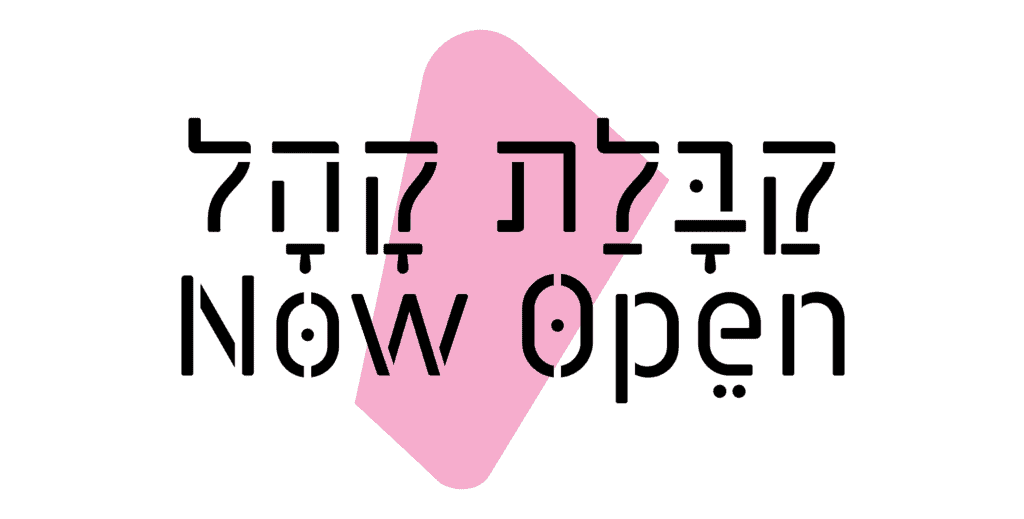
The exhibition Now Open delves into the relationship between the museum and its public. It presents projects created through extensive research processes by artists and creatives working with architecture, design, education, and performance. The participants were invited to intervene in the architectural and operational infrastructures of the Petach Tikva Museum of Art and offer interpretations and alternatives for the museum visiting experience.
As its name implies, Now Open celebrates the fulfilment of the awaited hope to reopen the museum doors after a long period in which culture and art institutions all over the world were closed to the public. At the same time, its asks how can we do this in a “healthier” way (and not only in the epidemiological sense): How to act as a more beneficial and meaningful public institution, which draws from the communities in which it is embedded, nurtures them, and maintains collaborative exchange and mutual learning? These questions are the extension of an ongoing process in which the Petach Tikva Museum of Art looks inward, with the intention of pushing and redefining its boundaries, and increasing public access to its resources as a social and political act.
The exhibition wishes to address these institutional quandaries and to offer the process of grappling with them as an artistic act. The works featured in it turn to look at the fundamental conditions and resources available to the institution – the environment, structure, lighting, signage – and to propose options for using and rethinking modes of movement and conduct in the museal space, as well as the exchange between the museum and its environment. They introduce playful and whimsical elements into the visiting experience, turn the visitor into an active participant in the formulation of the exhibition, and put forward essential questions of visibility, accessibility, and user experience. With this, the exhibition endeavors to position the museum as a functional public space that encourages human interactions, while setting in motion an ongoing process to make the discussion of the museum-community relationship more transparent and communal.
Or Tshuva
Exhibition curator
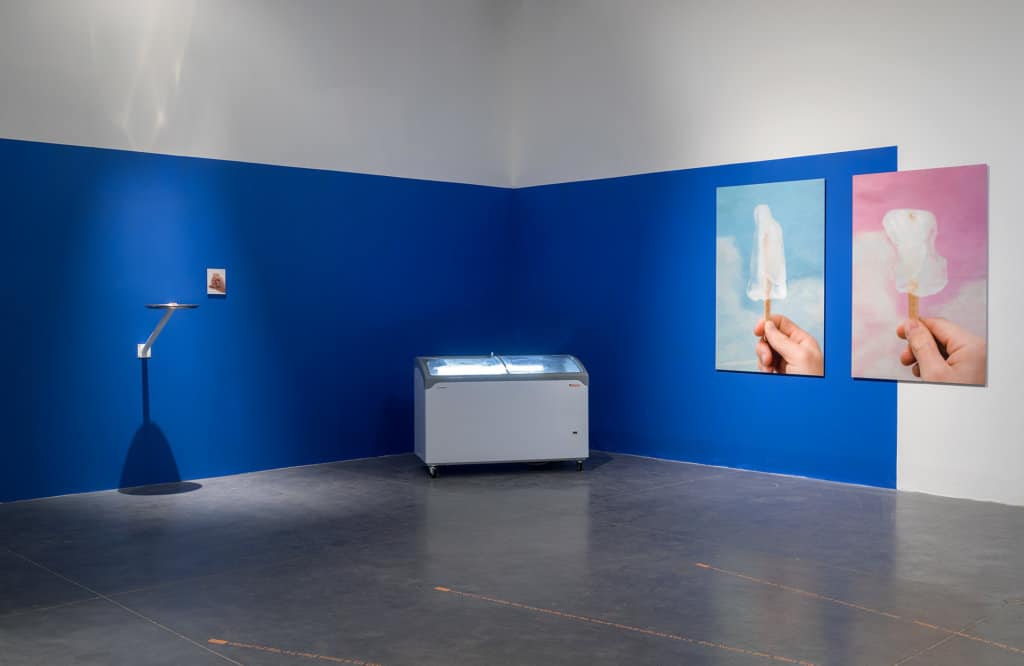
Interactive installation
Photography, sound, and sculpture
Music: Guy
The artist and chef Shahar Afek creates installations and performative pieces that combine the two worlds.
Wishing to change the conventional “sterile” rules of conduct in a museum, and drawing on the idea of feeding as an act of generosity and hospitality, his work invites museum visitors to take popsicles that he made from the freezer and eat them while wandering through the exhibition.
The installation Lick Me functions as an edible archive of physical actions and mental states. The work was born out of the artist’s personal experience, when due to an illness he had to avoid solid foods. On his doctors’ recommendation, Afek switched to an ice cream and popsicle-based diet. Designed to cool the oral cavity, soothe, and nourish the body, the popsicles became a source of comfort, allowing him to disconnect and dream. The popsicles are produced in several stages: First, Afek presses a lump of clay in his hands while performing different physical actions like dancing in the middle of the living room, sitting in a frog pose, walking towards the horizon and more. He creates silicone molds of the resulting figurines, which he then uses for casting the popsicles. The popsicle sticks are imprinted with verbal descriptions of the actions in which the molds were formed, which are revealed as the popsicle is eaten or melts away. The analogy between the popsicles and the artist’s body continues through a text written in the first person, which emanates from the freezer when the doors open, accompanied by music composed by Guy Cohavi, and declares: “Now I have set, I am good and ready, lick me.” The work wishes to serve as a pit stop that doubles as both an ideological and physical nourishment station in the museum.
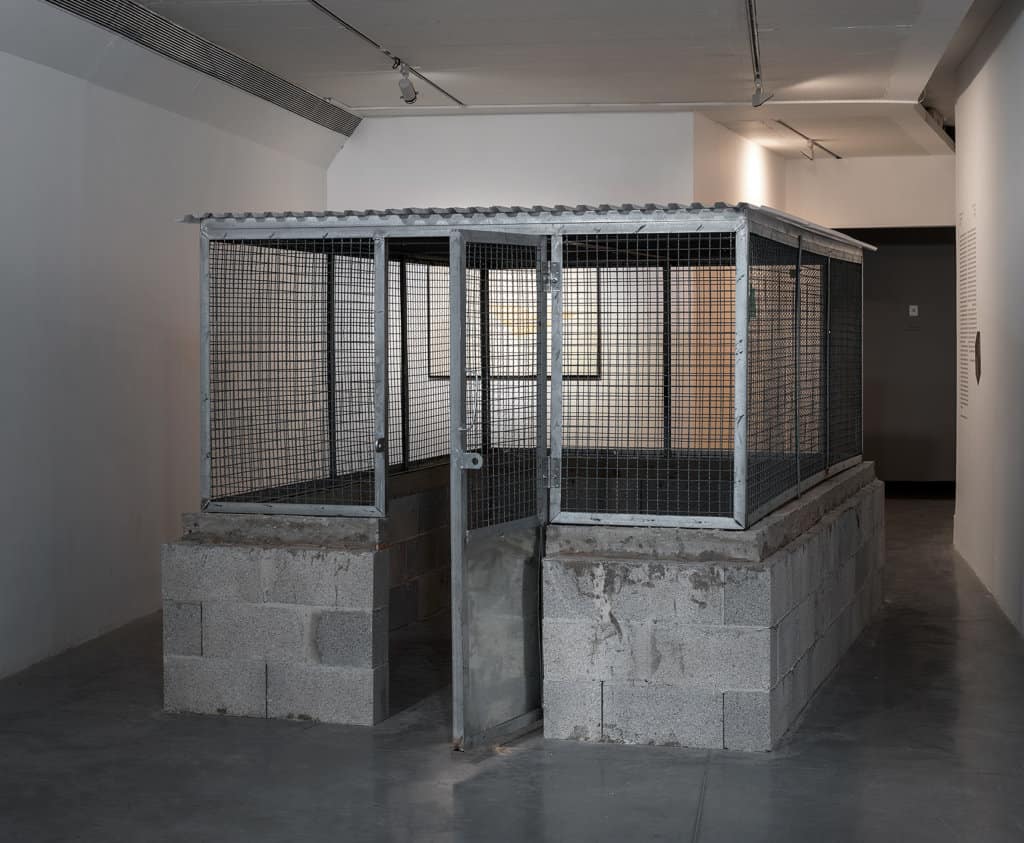
Installation and video
Mixed media
Cinematography: Itay Marom
With: Alex Krull
gym is an interdisciplinary group that explores the public space and operates in it. Its members are designers, architects, artists, and researchers who believe that the design of the public space requires integration of diverse ways of exploring, producing, and thinking. As part of the research carried out by gym at the Petach Tikva Museum of Art and its surroundings over the past year, the group mapped the public and semi-public spaces near the museum. The excursions throughout the nearby Ramat Warber neighborhood yielded documentation of temporary structures — some fulfill functional needs such as trash enclosures or clothes lines, others were constructed by children for their games, while the meaning of some remains obscure. The structure presented at the museum is an exact replica of one of the trash enclosures scattered throughout the area, which over the years have adopted other community uses, from storing personal belongings to displaying macramé crafts and paintings. The replication of the structure and its introduction into the museum creates a “transition space” of sorts, bridging the gap between the museum and its surroundings, and functioning as an in-between space, which fills, or possibly empties, the museal space.
The structure reappears in the video projected alongside it, establishing a mirror relationship between the physical object and the one in the video. The filmed monolog of museum guard Alex Krull shifts between ruminations about the present of the museum, the neighborhood, and beyond it, and imaginary global futures. This is the vision of a man standing on the threshold, in the liminal space that allows him to look from the inside out and from the outside in. The figure of the guard embodies the subtle tension between the representation of the institution and its interaction with the public, and his autonomous ability to look to the future as a prophet of sorts and offer new narratives for the role of the museum.
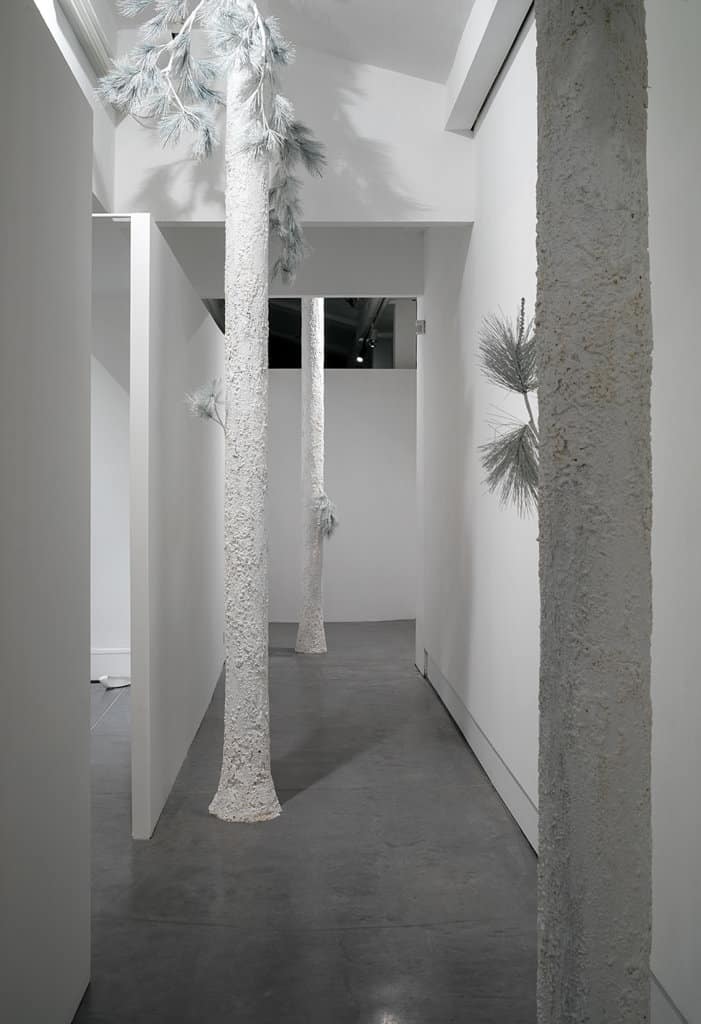
Installation
Mixed media
Acknowledgments: Amos Jerbi, Hagi Salmor, Hugi Shabi, Tsafrir Or,
Eitan Yaffe
Orly Hummel turns the back gallery of the museum into a huge white maze, in which she incorporates sculptural references to the museum complex, playgrounds, and frozen traces of an absent human presence. She transforms the “white cube” of the museum into a labyrinthine space of meandering and discovery, inviting viewers to play and follow its gleaming corridors. Hummel, who alongside her artistic practice is also a set designer, created an installation where the space and the sculptures function as one homogenous unit, beckoning visitors to immerse themselves in it. Throughout the maze she places architectural elements and functional objects taken from around the museum and the nearby Independence Park: a drinking fountain, benches, vegetation, and a game table. These have been replicated and adapted in the artist’s meticulous sculptural style, and now look like white fossils that break through the gallery walls.
Hummel’s maze is not only a playful puzzle in its contemporary meaning, but also carries its historical associations, from the labyrinth’s first iteration in Greek mythology to its different uses in the Middle Ages as a meditative space of ritualistic nature, emulating the search for God. At the same time, it also playfully alludes to the sense of disorientation or misunderstandings that are sometimes attributed to museums, wishing to counter them with an unmediated aesthetic experience.
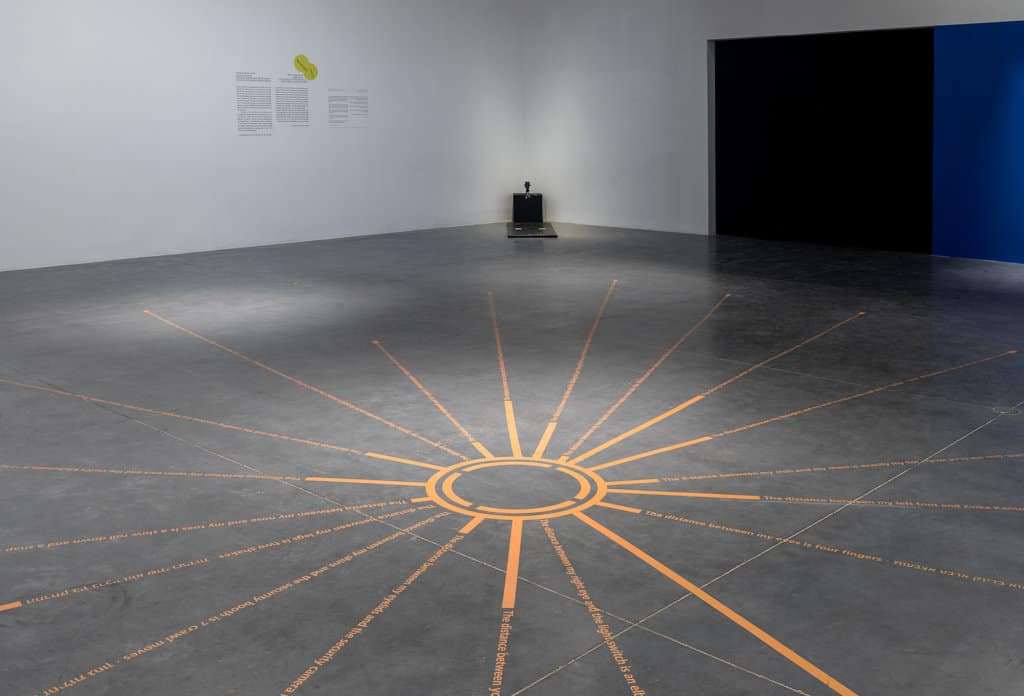
Text and floor installation,
Vinyl
Hello, 2020
Looped sound
Ofri Cnaani’s work explores possibilities of human presence, encounter, and intimacy, as well as the relationship between the human body and space. Informed by the spirit of these times, Local Tourism is a floor and text work that serves as direction and information signs of sorts (like those found near tourist sites), offering alternative ways to navigate through familiar places. Cnaani marks various landmarks and possible trajectories throughout the museum complex, using the visitor’s body as a measurement scale. Unlike traditional guided tours, these routes do not draw our attention to the artworks or to places of “touristic value,” but rather to infrastructures and administrations that are usually seen as “extraneous” to the exhibition, like the guard post, WiFi network, kitchenette, and even the museum staff.
The physical gestures with which Cnaani wishes to measure distances quickly reveal themselves as immeasurable, since these are not conventional steps or length units, but a series of choreographies and actions, including bunny hops, breaths, and air kisses — hinting at spaces that are not only physical but also cultural, social, and political. These routes/choreographies delineate an experience that is not necessarily contingent on the conditions specific to the space or the artworks in it, but one that wishes to leave a subjective imprint, and reassert that at the beginning and the end of all museum decisions and exhibitions lies the human element.
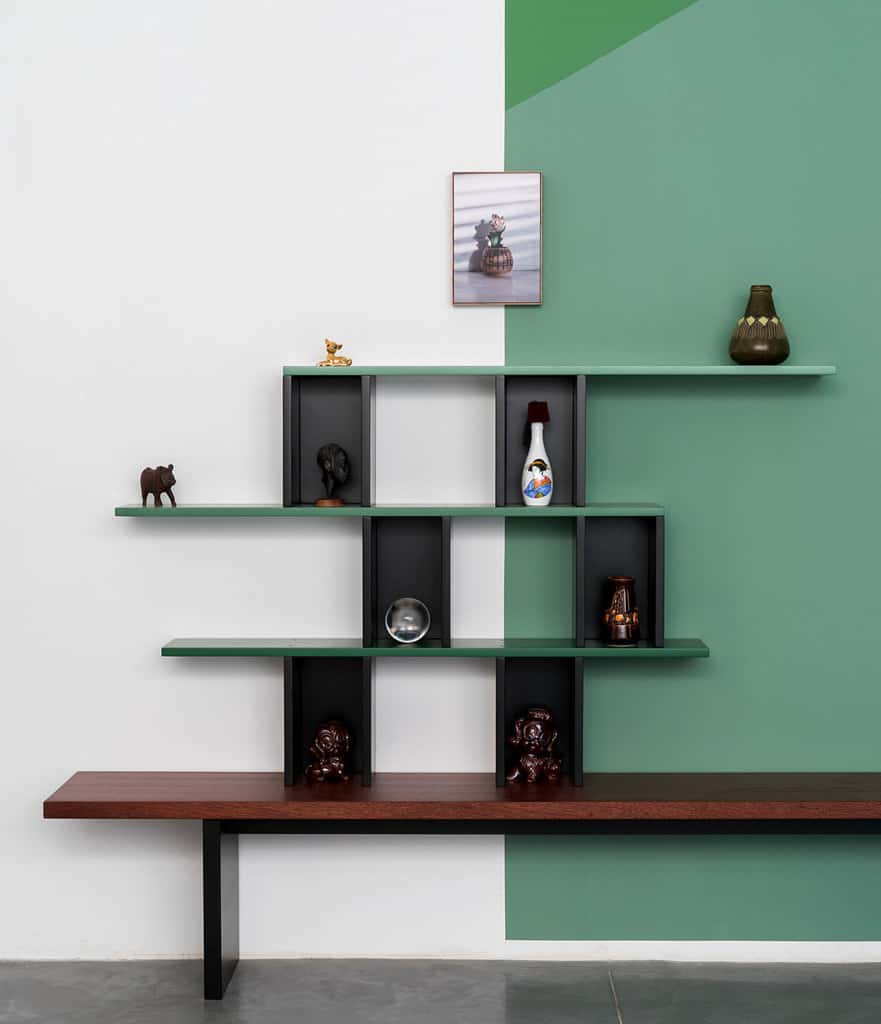
Installation
Courtesy of the artist and Braverman
Art Gallery Execution: The Print House
David Adika is a photographer whose installations bring together the two dimensional with the three dimensional, photographs and photographic environments design. In the piece created for the Petach Tikva Museum of Art, he shifts his exploration of the domestic space and interior design of private homes to a public waiting space — a lobby. Social media culture created the equation where being=taking photos (and of course, immediately sharing them online), and laid the foundations for an entire subculture of Instagram tourism and selfie museums. In an age where we constantly take pictures, a great part of the museum visit experience includes photographing and documenting the exhibitions and exhibits.
Adika’s Lobby is a lounging space that expands photography’s realm of activity. The sculptural environment created by Adika near the reception desk displays his distinctive aesthetics with a wealth of meticulous photography, geometric color fields, artifacts, and readymades that are integrated with each other. At the same time, it extracts itself from his exclusive control as a photographer and serves as a functional waiting environment that holds countless potential frames to be captured by the museum visitors.
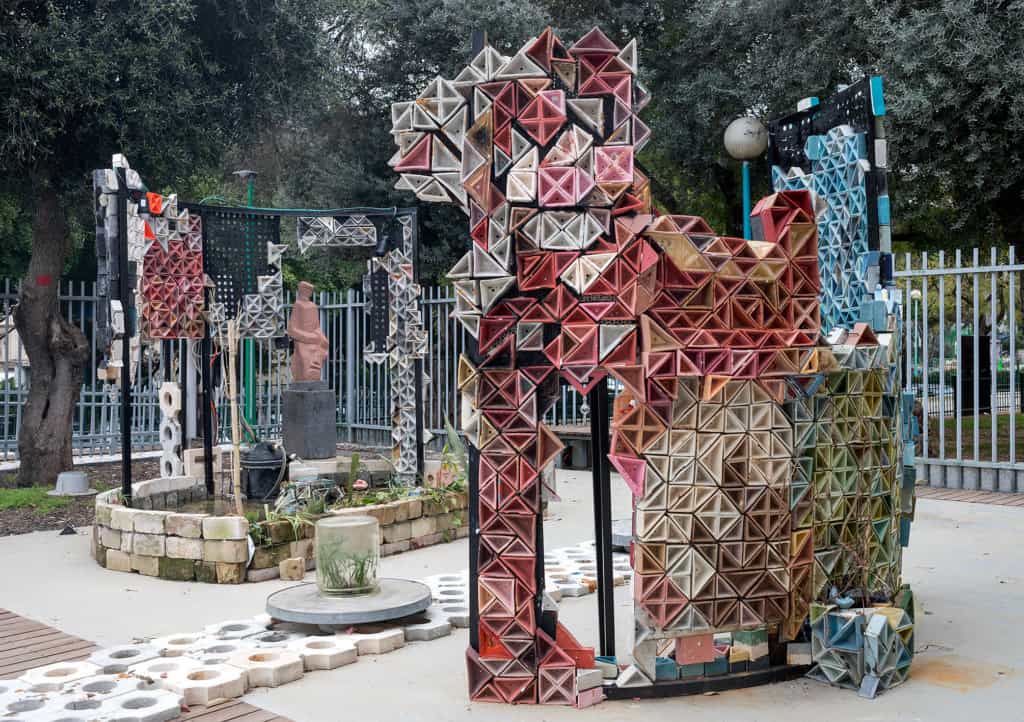
M’elabas (Dresser), 2020
Site specific installation
Mixed media
Along with a human circulation of visitors and museum staff, the museum complex also houses an extensive and vibrant ecosystem of secondary tenants. Birds, bats, stray cats, and occasional guests from the nearby zoo and park have turned the museum and surrounding vegetation into their home, and live in symbiosis with the people and the artworks in the area. Focusing on this ecosystem, Yaniv Amar builds a sculptural installation that serves as a nesting and feeding station for the museum’s inhuman occupants. The piece centers around a water basin surrounded by vegetation and a system of hollow bricks made of organic materials that provide nourishment and hiding nooks for birds and bees. The installation is based on an internal purification system and functions as an autarkic habitat, where the various plants and animals feed each other. other.
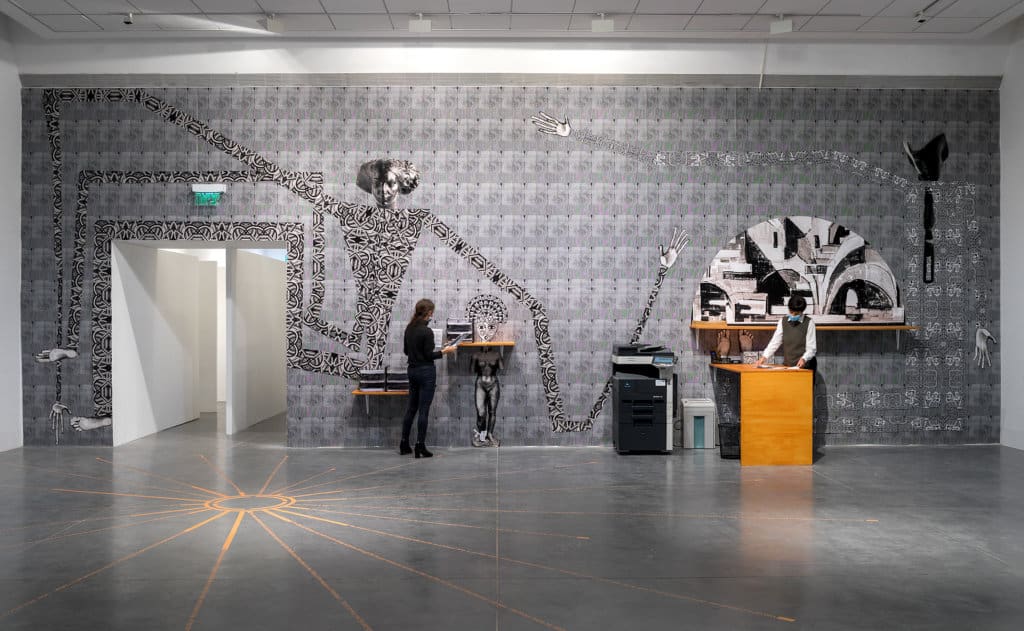
Installation
Wall assemblage, paper, adhesives, wood, transparencies, stationery,
paper shredder, photocopier
The exhibitions at the museum are usually displayed over several months, during which they will be visited by thousands of people. These will come and go, but in most cases the exhibition remains unchanged. Luciana Kaplun and Ruti de Vries wish to make the direction of influence between the exhibition and the public more reciprocal, and to allow visitors to interpret, appropriate, and leave their mark on the exhibition. The designed workstation the two have set up in the exhibition space includes a desk, a photocopier, a paper shredder, along with stationary, texts and official photographs the museum produced as part of the exhibition. The public is invited to use all of these to document, edit, and create their own individually designed souvenirs and catalogs.
The monumental paper collage that the artists created for the installation is based on works from the museum’s art collection, photocopied body parts, and graphic patterns they designed, and demonstrates a similar conceptual act of appropriation and assembly that draws on the museum’s resources.
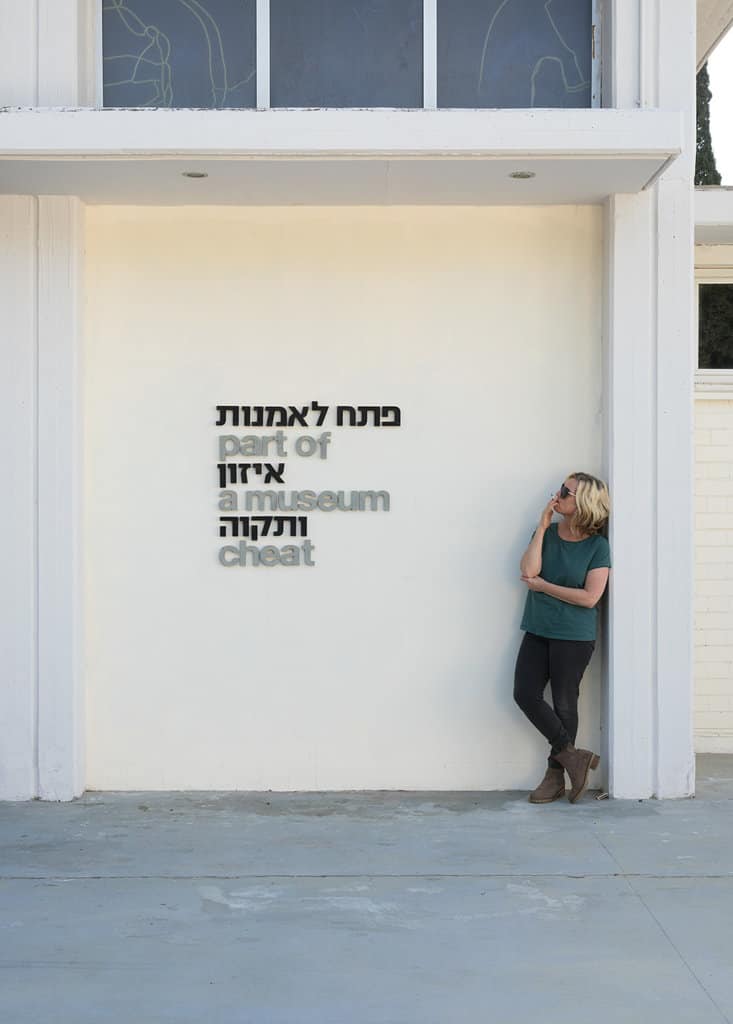
Video installation, 11 min.
Accompaniment and consultation: Itamar
Mendes Flohor Cinematography: Itamar
Mendes Flohor Drone cinematography:
Barak Brinker Programming: Amir Boltzman Dog trainer: Doron Dog
Training Editing: Dan Robert Lahiani,
Renana Aldor Foleys: Tal Steinberg Dog:
Albi Acknowledgments: Mamuta Art And
Research Center, Ofer Loufer, Shimri
Hagai, Sagit Mezamer, Galina Lulko, Shai
Persil, Michal Gassner, Roy Golan
Yehudit Shlosberg Yogev’s video work offers an alternative perspective on a visit to the museum and its surroundings from a bird’s eye view. In the video’s opening scene, the frame follows a dog hurrying towards an unknown location. The animal’s urgent dash is replaced by an aerial view filmed from a drone that trails it, exposing the geographical connection between the museum, the park, and the zoo and the fact that the Petach Tikva Museum is surrounded by vibrant urban nature. The run is interrupted abruptly when the panting dog reaches its destination, which turns out to be the entrance to the museum.
The perspective offered by the drone engenders alienation and distance from
the cultural baggage and the familiar route of the museum and conjures up military associations of surveillance and attack, hinting at an impending disaster. Gradually, smoke begins to rise from the roof of the building, until a huge, burning hole opens in it. It becomes clear that the event that the viewers are witnessing is in fact footage of the screening, and the fire is not an aftereffect as one might expect, but rather the documentation of the projection screen itself as it catches on fire. The sound that accompanies the video comprises materials that were recorded in the neighboring Independence Park. These were compressed in a digital process to the point of overload, leading to the disintegration of the sound alongside the image’s breakdown.
The destruction of a museum — an institution created for the protection and preservation of nature and historical cultures — is in fact the destruction of culture’s “last resort,” perceived as a threat to the whole of collective human memory. Under these circumstances, Shlosberg Yogev’s video work points to the constant tension between the natural and the civilized, the real and the mediated, on the backdrop of impending calamity. The spectators watch the destruction of the building in which they sit as an out-of-body experience, where human culture dissolves back into nature. The return to the “zero point” becomes an aesthetic and sensory experience but also a reflection on the state and value of the museum in an age of technological acceleration and global crisis.
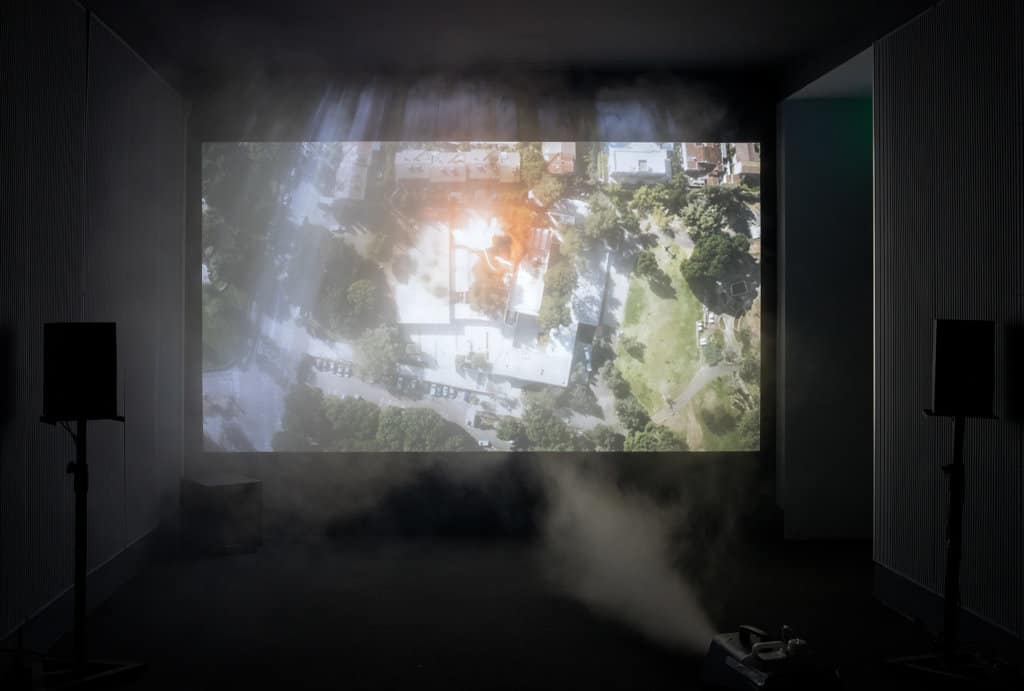
Mobile phone charging station,
Arduino computer, touch sensors, MDF, yoga mats, printed PVC tarpaulin
In collaboration with:
Shirel Horovitz, Erez Duchan
Maya Sharabani’s Charging Altar offers a critical and playful examination of our ability to be fully immersed in the museum visit experience, in light of the inability of most of us to disconnect from our mobile phones. We capture memories, navigate, work, find love, tell the time, and communicate with the outside world through our smartphone. When it is in our pocket or bag, we sometimes imagine phantom rings or vibrations, and when the battery is dead, we feel social anxiety known as FOMO (fear of missing out).
Visitors to the museum sometimes ask to charge their mobile phones at the reception desk, in the offices, or even use the outlets in the museum galleries. The work — which is in fact a mobile phone charging station — was inspired by them. The station is activated by touch sensors, so that in order to power the charger, users have to position their hands, knees, and feet according to the marking and, in fact, “bow down” to their mobile phones.
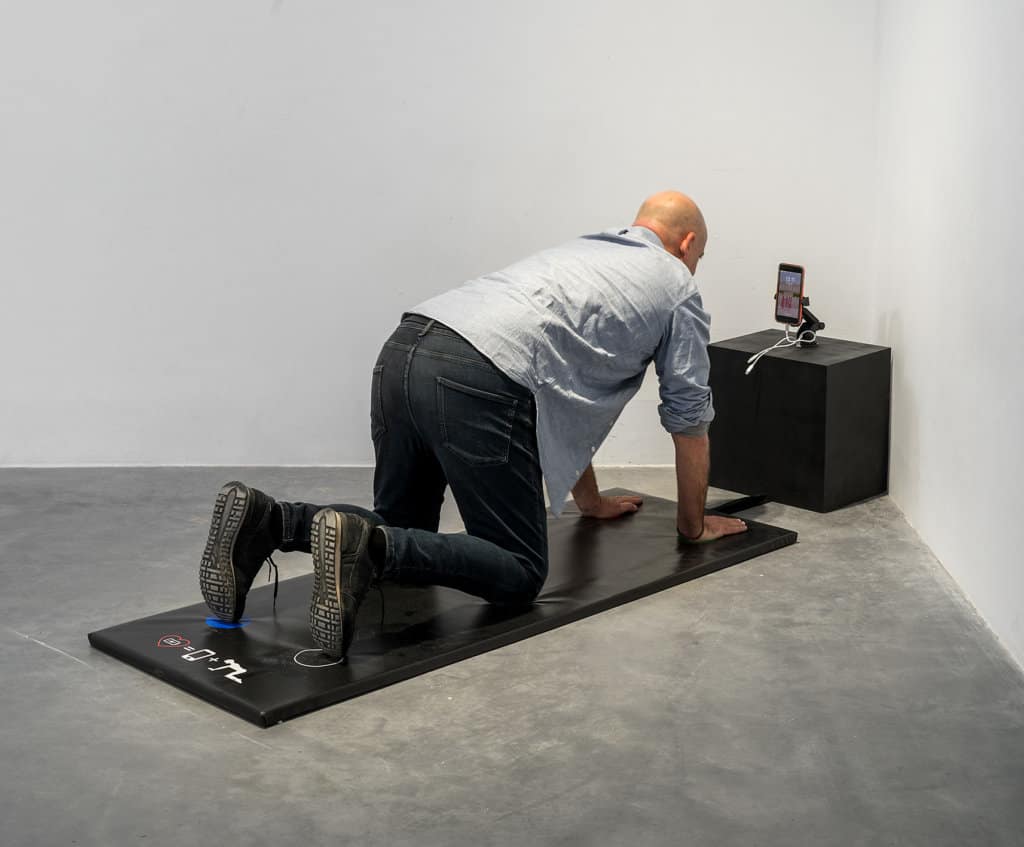
CNC cut Perspex letters
Catalog, 2020
Video installation
15 blank hardcover books,
video projection
Participants: Amnon Yuhas,
Samuel Beraud Letz, Roni Ben Porat,
Carmel Barnea Brezner Jonas,
Mikka Chesno, Nuphar Shetu,
Nadav Verta, Tomer Tzur, Joram Rozov,
Shirley Faktor, Danielle Fischer
Banner, 2020
Manipulated readymade
PVC tarpaulin, mirror, digital printing
Yasha Rozov carries out various artistic interventions in the museum’s information platforms, including the museum’s logo at the entrance, exhibition banners, and the catalog display stand at the reception desk. As an artist and designer by training, Rozov takes on the museum’s graphic infrastructure, which is often left outside the scope of the artists who exhibit at the museum, and appropriates it as an alternative display platform. In the museum’s logo, for example, he rearranges the letters to create a play on the Hebrew meaning of Petach Tikva (lit. “Gate of Hope”), while the banner in the courtyard is now an empty template, where the word “image” has been replaced by a mirror that reflects those who stand before it. The power of these artistic actions lies precisely in their ability to maintain the existing design templates, so that many may not notice them at first glance. These turn the artist into “the invisible man,” who infiltrates the institutional infrastructure and embeds his own messages in it. In the video he created for the reception desk, Rozov performs almost the opposite action, where the hands that flip through the empty books wish to breathe life into the display wall of the still catalogs, which are on permanent display behind the desk.
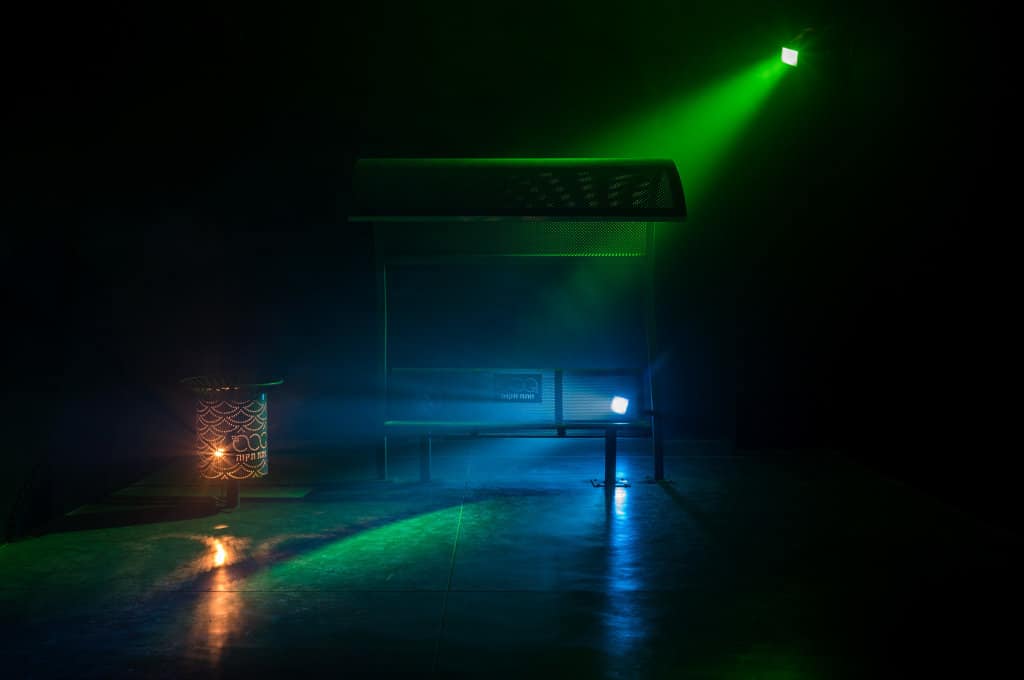
Installation
Mixed media
The work was produced with the support of Leshem, Tel Aviv Museum of Art
Omer Sheizaf is a lighting designer and artist who creates site-specific sculptural light installations. While lighting is often seen as a supplementary layer that is added to the artwork or projected on an object and exists in relation to it, in this project it functions as the starting point and an independent sculptural object. Assuming that space design also largely dictates the behavior and feelings of those who inhabit it, the focus on the lighting infrastructure in this exhibition sets out to exercise its power in creating a welcoming and sensory experience that does not necessarily require outside interpretation or mediation.
At the center of the space, which is flooded with colorful beams of light projected on the walls and floor and merging with each other, Sheizaf has placed an outdoor street bench. The bench plays a dual role: A seating element, inviting visitors to slow down and linger in the space as it changes around them, and a readymade object that allows the light to pass through it, creating different patterns that flash around the space. Using lighting and relatively simple mechanisms, the work transports the nondescript outdoor furniture into the museum, conjuring a theatrical and astonishing experience, and turn the gaze to infrastructures that often remain unnoticed.

